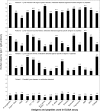Novel Diagnosis of Lyme Disease: Potential for CAM Intervention
- PMID: 18955246
- PMCID: PMC2722197
- DOI: 10.1093/ecam/nem138
Novel Diagnosis of Lyme Disease: Potential for CAM Intervention
Abstract
Lyme disease (LD) is the most common tick-borne disease in the northern hemisphere, producing a wide range of disabling effects on multiple human targets, including the skin, the nervous system, the joints and the heart. Insufficient clinical diagnostic methods, the necessity for prompt antibiotic treatment along with the pervasive nature of infection impel the development and establishment of new clinical diagnostic tools with increased accuracy, sensitivity and specificity. The goal of this article is 4-fold: (i) to detail LD infection and pathology, (ii) to review prevalent diagnostic methods, emphasizing inherent problems, (iii) to introduce the usage of in vivo induced antigen technology (IVIAT) in clinical diagnostics and (iv) to underscore the relevance of a novel comprehensive LD diagnostic approach to practitioners of Complementary and Alternative Medicine (CAM). Utilization of this analytical method will increase the accuracy of the diagnostic process and abridge the time to treatment, with antibiotics, herbal medicines and nutritional supplements, resulting in improved quality of care and disease prognosis.
Keywords: Borrelia burgdorferi; Lyme disease; in vivo-induced antigen technology; multi-peptide ELISA.
Figures



Similar articles
-
Testing Raman spectroscopy as a diagnostic approach for Lyme disease patients.Front Cell Infect Microbiol. 2022 Oct 27;12:1006134. doi: 10.3389/fcimb.2022.1006134. eCollection 2022. Front Cell Infect Microbiol. 2022. PMID: 36389168 Free PMC article.
-
Polymerase chain reaction in diagnosis of Borrelia burgdorferi infections and studies on taxonomic classification.APMIS Suppl. 2002;(105):1-40. APMIS Suppl. 2002. PMID: 11985118
-
Multiomics Reveals Symbionts, Pathogens, and Tissue-Specific Microbiome of Blacklegged Ticks (Ixodes scapularis) from a Lyme Disease Hot Spot in Southeastern Ontario, Canada.Microbiol Spectr. 2023 Jun 15;11(3):e0140423. doi: 10.1128/spectrum.01404-23. Epub 2023 May 15. Microbiol Spectr. 2023. PMID: 37184407 Free PMC article.
-
The Brilliance of Borrelia: Mechanisms of Host Immune Evasion by Lyme Disease-Causing Spirochetes.Pathogens. 2021 Mar 2;10(3):281. doi: 10.3390/pathogens10030281. Pathogens. 2021. PMID: 33801255 Free PMC article. Review.
-
[Borrelia infections of the skin--progress of knowledge since the discovery of Lyme disease].Hautarzt. 1991 Jun;42(6):356-65. Hautarzt. 1991. PMID: 1917458 Review. German.
Cited by
-
Recent strategies for the diagnosis of early Lyme disease.Sci Prog. 2018 Oct 1;101(4):311-331. doi: 10.3184/003685018X15360040523730. Epub 2018 Oct 8. Sci Prog. 2018. PMID: 30296967 Free PMC article. Review.
-
The use of hydrogel microparticles to sequester and concentrate bacterial antigens in a urine test for Lyme disease.Biomaterials. 2011 Feb;32(4):1157-66. doi: 10.1016/j.biomaterials.2010.10.004. Epub 2010 Oct 28. Biomaterials. 2011. PMID: 21035184 Free PMC article.
-
TickPath Layerplex: adaptation of a real-time PCR methodology for the simultaneous detection and molecular surveillance of tick-borne pathogens.Sci Rep. 2019 May 6;9(1):6950. doi: 10.1038/s41598-019-43424-y. Sci Rep. 2019. PMID: 31061487 Free PMC article.
-
Application of droplet digital PCR to detect the pathogens of infectious diseases.Biosci Rep. 2018 Nov 15;38(6):BSR20181170. doi: 10.1042/BSR20181170. Print 2018 Dec 21. Biosci Rep. 2018. PMID: 30341241 Free PMC article. Review.
-
Suppression of ongoing experimental arthritis by a chinese herbal formula (huo-luo-xiao-ling dan) involves changes in antigen-induced immunological and biochemical mediators of inflammation.Evid Based Complement Alternat Med. 2011;2011:642027. doi: 10.1155/2011/642027. Epub 2010 Oct 19. Evid Based Complement Alternat Med. 2011. PMID: 20981317 Free PMC article.
References
-
- Steere AC, Grodzicki RL, Kornblatt AN, Craft JE, Barbour AG, Burgdorfer W, et al. The spirochetal etiology of Lyme disease. N. Engl. J. Med. 1983;308:733–40. - PubMed
-
- Steere AC. Lyme disease. N. Engl. J. Med. 1989;321:586–96. - PubMed
-
- Kantor FS. Disarming Lyme disease. Scientific American. 1994;271:34–9. - PubMed
-
- Bock SJ. The integrative treatment of Lyme disease. Int. J. Integ. Med. 1999;1:19–23.
-
- Howenstine J. New ideas about the cause, spread and therapy of Lyme disease. Townsend Letter for Doctors. 2004;252:64–7.
LinkOut - more resources
Full Text Sources
Research Materials

